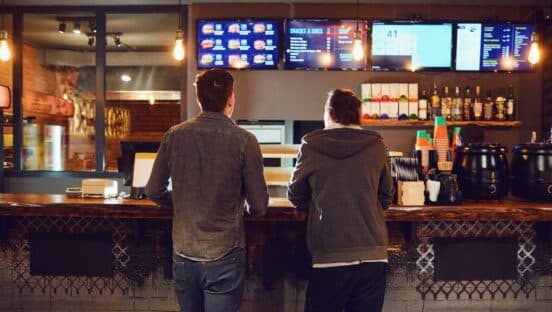Sponsored by HigherMe.
Finding the right employees is crucial for restaurants, but in today’s competitive job market, brands must compete for top talent. This makes it more important than ever for leaders to ensure they source and retain candidates by making a strong impression on job seekers. This impression begins even before employees are hired. In fact, the application process can play a large role in the candidate’s decision to apply or ultimately choose to work for a company. On top of that, outdated applications, even online ones, can be a liability when it comes to recruiting.
The Bureau of Labor Statistics reports that the U.S. economy now has 7.6 million more jobs than the pre-recession peak and unemployment is shrinking. With growing opportunities for employees, it isn’t surprising that the Bureau of Labor Statistics also reports that turnover topped 70 percent in the hospitality sector for the second year in a row.
“The whole socioeconomic labor market has gotten tighter, and it’s harder to source great candidates,” says Rob Hunter, CEO of HigherMe, a company that uses technology to improve the hiring process for employees and managers. “A lot of employers think that sourcing and the way that applicants apply for jobs are not related. What we’ve found is that the ease with which someone can apply heavily contributes to whether a candidate actually applies.”
As a former multi-unit franchisee for Marble Slab, Hunter noticed there was one big flaw with many of today’s restaurant application systems—they use older technology that is not only unappealing, but difficult to use, especially from mobile devices. Though many leaders feel that the best applicants won’t be deterred by difficult applications, Hunter says it’s often the best candidates who aren’t willing to “put up with that friction” because they have other options.
Eliminating friction for both applicants and the managers who must review their submissions and make hiring decisions is a critical step in improving the hiring process. Using the right technology brings applications into the current era and helps restaurants engage talent throughout hiring and onboarding.
Applicant tracking systems (ATS) streamline application processing for managers while simplifying application requirements for applicants. With older systems, potential employees often start applications but don’t finish them. Newer platforms, like HigherMe, boost completion rates.
“The application completion rate averages 20–30 percent with older systems,” Hunter says. “Our application completion rate is 70–80 percent.”
One reason for this dramatic difference is that HigherMe uses advanced technology to screen applicants without asking them to fill out traditional long-form assessments. Despite the fact that its ATS moves away from traditional assessments, HigherMe’s platform is just as effective—if not more—in selecting the right candidates. This is accomplished through predictive algorithms, which pre-screen applicants to ensure they will be right for the chain.
“There is so much data available to us these days we can build predictive analytical models to find out who will fit a brand and who won’t,” Hunter says. “We capture just enough information so that we do it in a more efficient way than a traditional 200-question assessment.”
Managers also see tremendous improvement, because they don’t have to manually screen every applicant or sort through applications in clunky systems.
“This technology is wonderful for independents that just don’t have the resources of larger chains,” Hunter says. “I was a franchisee with seven Marble Slab stores, and I can’t overstate the value of not spending an hour sending emails and leaving voicemails. This technology has a major transformative effect, especially for anyone who is hiring more than once a month.”
Another reason for HigherMe’s strong results is that it puts applications where applicants are most likely to be—on their phones. Because demographics are shifting toward younger applicants who expect mobile integration, offering new application methods that integrate smart phones can boost the number of candidates hiring managers receive.
“About 70 percent of new hires in foodservice are 27 or younger,” Hunter says. “Most of that generation grew up never being without the Internet—or on the lower end of the age range, never being without a smart phone. Smart phone penetration and ownership is at an all-time high, while laptop and desktop ownership is at a decline.”
For this reason, restaurants must branch into the mobile space to get the best candidates. HigherMe, for example, engages employees through text messaging to reduce the friction of browser-based applications. Pairing this functionality with in-restaurant “Text to Apply” posters tells candidates that filling out applications is simple and won’t take up much of their time.
“Great applicants are often busy and may not have time to fill out traditional applications, or they may come in after hours when a manager isn’t at the store,” Hunter says. “This helps restaurants capture these folks who otherwise might not apply but could be great employees.”
Additionally, the system keeps candidates engaged throughout the hiring process. HigherMe sends applicants notifications to encourage them to finish applications.
“The system is a bit like Amazon,” Hunter says. “If you put something in your digital cart but don’t complete the purchase, you continue to see ads for the product. When applicants don’t finish applications, we’ll send texts and emails to motivate them to come back to the application.”
Candidates also receive notifications of where they are through the selection process so that they know the status of their application.
“Often when people submit resumes or applications, it’s a bit like releasing them into a black hole with no feedback coming from the other side,” Hunter says. “We humanize the process with technology, as counterintuitive as that sounds.”
Even when employers decide not to hire candidates, the system’s notifications keep employees informed, which improves feelings about the process and can bring other valuable benefits to the business.
“Staying in contact can do a lot for a brand,” Hunter says. “Even if an applicant isn’t selected, communication can make them feel more positively about the brand so that those people remain customers or even remember their good experience and tell others to apply later.”
Elevating the hiring experience can pay restaurants big dividends, from labor and payroll savings through minimizing turnover disruptions to improving customer experience with superstar employees. Not only is an advanced ATS a smart way to save money; it’s an investment in the most important assets brands have—their people.
By Peggy Carouthers













